At weedom, June is day lily month during which this particularly attractive, invasive weed is celebrated by trimming out the overgrowth along the front fence line. This is a job that we hate, because a good part of that growth is poison ivy, but we suffer through it so we can view the profusion of orange blossoms which put up a strong show for 3-4 weeks. This year, exposing the day lilies required about 4 hours of weed and brush clearing for 2 people. The clock was ticking as we weed whacked and chain sawed. We deposited the poison ivy separately, and the rest went into our brush pile. Then we ran for the showers and broke out the jewelweed soap to help remove the urushiol of the poison ivy that had been sprayed all over us.
This summer, there’s not such a floral abundance due to drought. Our day lilies are struggling along, at about 25% of usual density, but we know these perennials will be back next year if it rains. Why don’t we just “nuke” the fenceline? Because we really like our weeds, and we don’t want herbicides everywhere.
Perhaps the main reason that day lilies have escaped into the wild, and taken over much of the roadside real estate in the U.S. is that most people don’t know you can eat them. The blooms and buds are Chinese food.
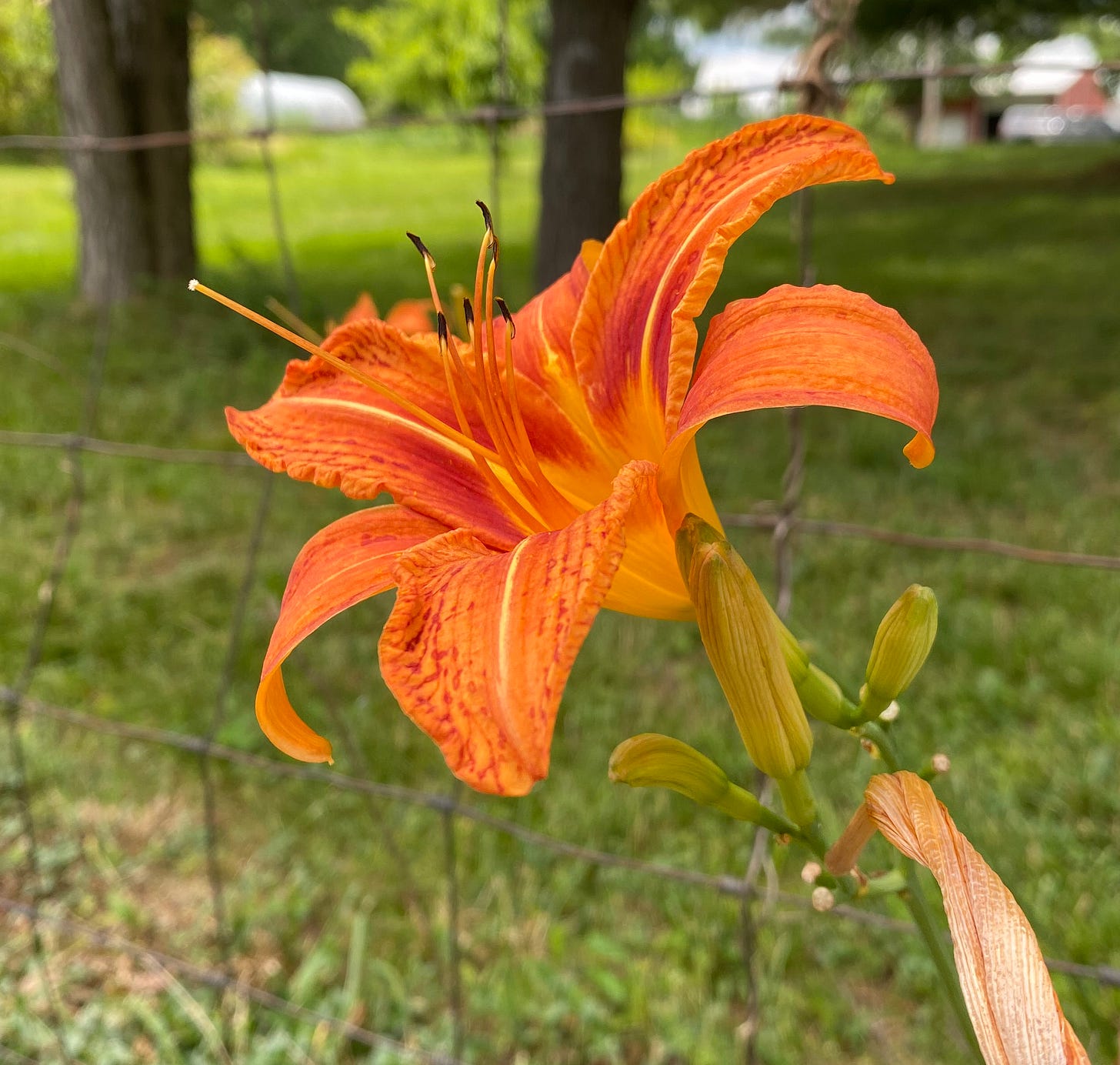
Other parts can be eaten too, particularly the little tubers, the shoots, and young leaves. Leaves and tubers are much more work to prepare, which might be why they’re called famine food.
The fact that these plants are edible tells us that their common name is misleading. Day lilies, Hemerocallis fulva, aren’t lilies at all, despite the shape of their flower, and character of their foliage. They’re from the family, Asphodelaceae. Cats may experience some toxicity if they consume this weed, but most humans find it quite edible, though a small proportion might suffer some gassiness and a bit of nausea. Eating large portions might increase this possibility, and cause bit of diuretic action as well.
While our region sees wild H. fulva growing in profusion, and we know those are tasty, there are about 20 or so edible species or varieties of Hemerocallis, with a variety of bloom colorations which we personally have not tried. Therefore we would approach each type with a bit of caution, eating small amounts first before preparing a large serving. There exist reports that the green leaves are hallucinogenic if eaten in large quantity. The young white portions seem to be more tolerable. Blanching is said to reduce the hallucinatory qualities.
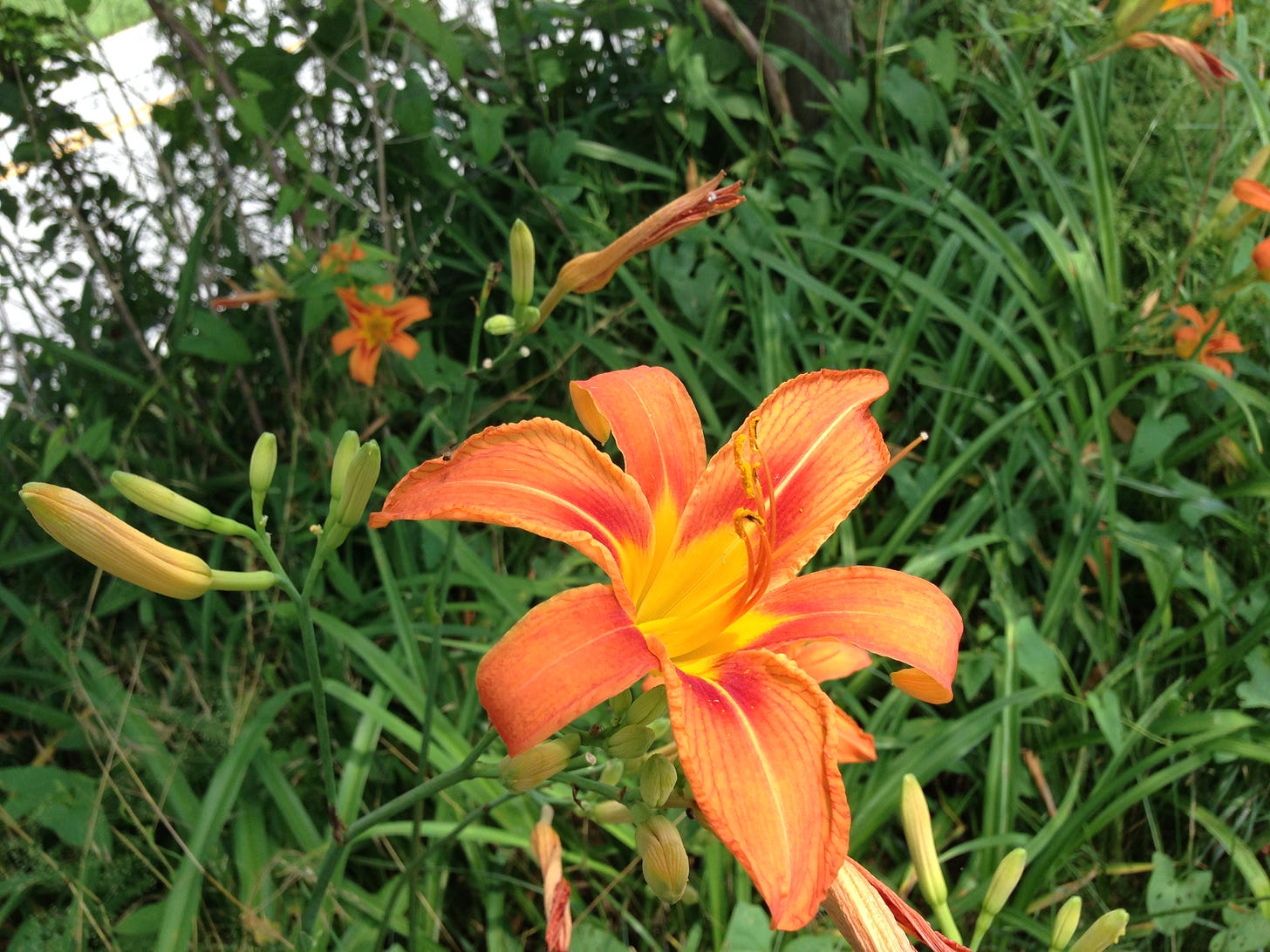
Simple, sword-shaped, or strap-like leaves, which usually remain less than an inch wide, arise from the rhizomes at the base of the plant. The leaves have a distinct central fold. As they lengthen, they droop or curve downward. After flowering the leaves often die back as the summer season becomes drier. They might grow back with increased rain in the fall, but die to the ground each winter, to arise again in the spring. Roots occur in crowns with small tubers, which some take the trouble to eat, though at weedom, we’re too lazy thus far. In contrast, plants of the lily family arise from inedible bulbs. A video is available at identifythatplant.com which gives a good view of the youngest day lily plants, and the entire life cycle.
Flowers have six tepals, which occur as overlapping sets of 3 petals (inside) and 3 sepals (outside), forming a trumpet shape, 3-6 inches across. The word ‘tepals’ is used generally when a flower’s petals and sepals are similar in appearance. The stalk which bears the flowers is entirely hairless and without leaves, though sometime a single bract below the flower may be present. These flowers have considerable weight, firmer and sturdier than many squash blossoms, and therefore are superior for such things as tempura. They share a somewhat crunchy quality with the edible yucca blossoms, and romaine lettuce. Six anthers and a single long style of the pistil project prominently from the flower, and are likewise edible. Normally butterflies and hummingbirds are attracted to these blooms, but we have a shortage of such creatures during this year’s dry weather. Flowers most often do not produce seeds capable of forming new plants, so that proliferation of this plant is largely by spreading rhizomes.
To prevent people from nibbling on the ‘do-not-eats’, here are some look alikes among native lilies. Wood Lily, Lilium philadelphicum, has petals which become narrow towards the base where they enter the calyx, and whorls of leaves on the flower bearing stems (peduncles). Pine Lily, Lilium Catsbaei, has a more delicate looking flower with more narrow petals which do not form an overlapping cup at the base, and lance shaped leaves that clasp the flower bearing stem. Other plants you should avoid eating are the cultivated Asian lily species, which appear ubiquitously in garden centers every spring, and in our landscapes. True lilies are toxic to varying degrees.
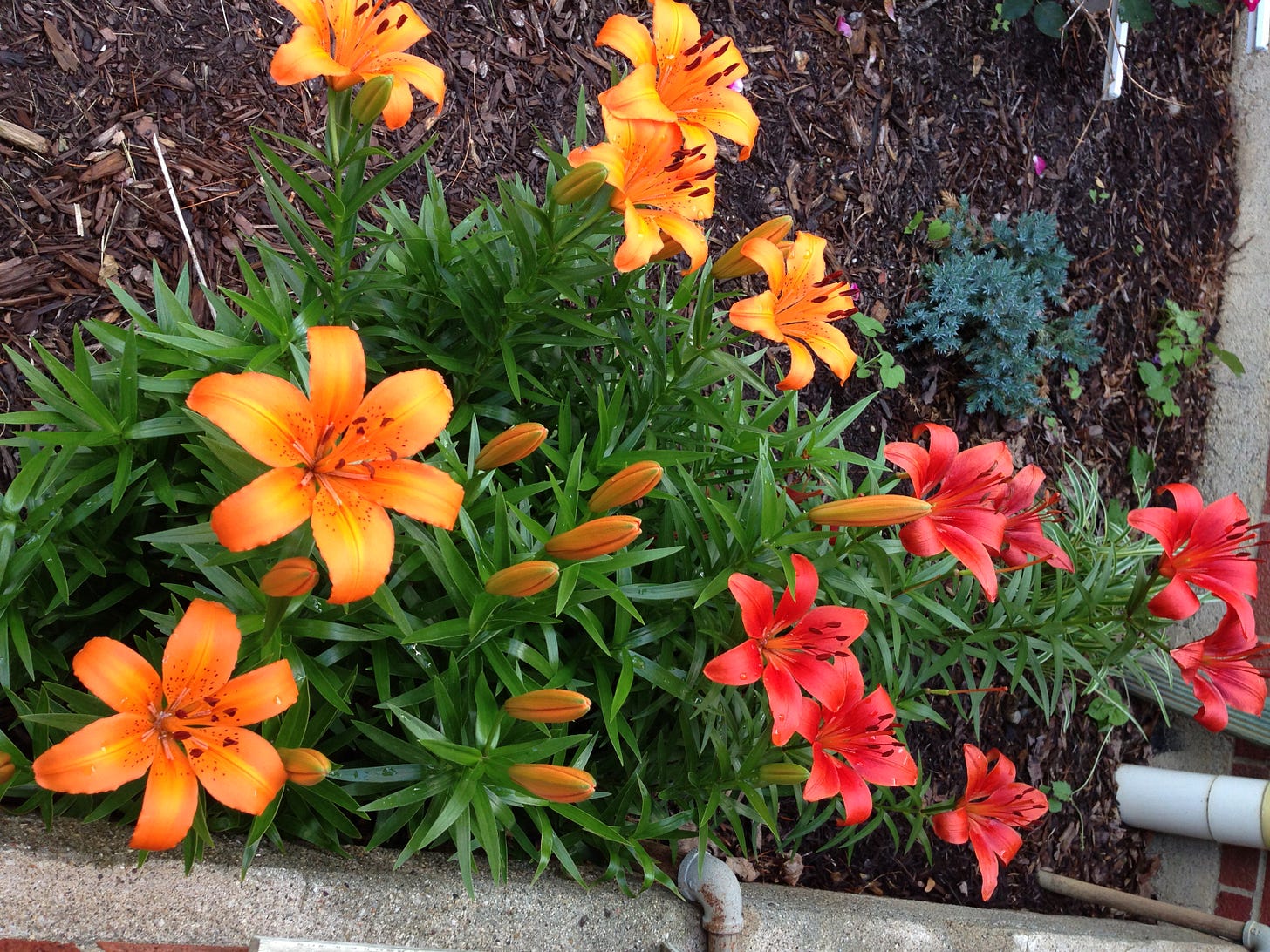

Nailing down the species of Hemerocallis is quite difficult since varieties which might have appeared to be of different species are known to mix and merge in nature. Botanists largely threw up their hands regarding the species. You will hear mostly of accessions and varieties of this plant. Use of compounds such as colchicine to inhibit mitosis has produced triploid and tetraploid varieties which are entirely sterile. Hemerocallis fulva varieties differ with respect to their fertility by seed.
Hemerocalis citrina, a yellow flowered species, is widely cultivated as food in China. There is great interest in the mechanics and timing of flower opening and closing, since this all occurs within a single day. The pigments of the flowers (secondary metabolites that accumulate in the vacuoles of epithelial cells) are studied intensely due to their nutritional and medicinal qualities. In contrast, both the Day Lily Society and the Hemerocallis Society of the U.S. are primarily dedicated to appreciation of floral beauty.
Reaching into A Barefoot Doctor’s Manual, we find that Hemerocallis fulva, Hsuan Ts’ao or Xuan Cao, is regarded as moderately cooling, and used to treat edema, urinary stones, jaundice, constipation, bloody nose, blood in stool, breast abscess. It’s ‘all about tea’ in China, with the use of aqueous infusions being predominant in the natural medicine there. A dose of the floral decoction is made with 4.6 to 9.3 grams of the dried flowering parts. The root decoction is also used for urinary disorders, but is regarded as more toxic. In Korea, the root has been considered as a treatment for filariasis, liver disorders, certain cancers and bacterial infection. The root juice has been used as an antidote for arsenic poisoning.
Saving a popular use for last, Hemerocallis is named as the “forget one’s sadness” herb in China, and there’s a good deal of chemical and clinical evidence to support this usage. Both H. fulva and H. citrina produce numerous compounds which can help to lift the mood by multiple mechanisms. The salutary effects of the floral extracts were observed in various animal depression models, (which in and of themselves are depressing to observe). Hesperidin and rutin are two of the compounds associated with the positive responses in the animal studies, and have been connected mechanistically to observed increases in serotonin and dopamine levels in the central nervous system. Sedative effects, and improvement of memory disorders have also been observed. It’s generally depressing to be sleepless, and conversely, depression can aggravate sleeplessness. A study of humans in Japan showed sleep improvement associated with dietary addition of Hemerocallis flowers, an effect which declined in the following week after the supplementation was stopped. Positive mood modulation can also occur through this weed’s ability to alleviate constipation. It encourages beneficial gut flora, and seems to increase frequency of defecation without speeding up the transit of digested materials through the GI tract. A good dump can be quite uplifting. :-D
Dried Hemerocallis fulva buds, called gum jum choi or ‘golden needles’ are sold in Asian grocery stores. The buds are harvested when they’re about 4 or 5 inches long, and the dried forms might be 2-3 inches long. They should be light brown and somewhat flexible. If they are dark and very brittle, they’re not in good condition. The dried buds can be rinsed then rehydrated in warm to hot water, for anywhere between 30 minutes to 2 hours. Cut off the hard knob at the end of each bud, then stir fry with other vegetables, or add them to soup recipes. In early summer, you can choose to stir fry the freshly collected buds of your own crop, if they’re available. Dry some for later. As with other herbs, you’ll retain maximum benefits by drying as quickly as possible in an unlit area. Store them in a cool dark place. The opened flowers can be added to salads, or battered and fried as you would do with squash blossoms. Flowers which are somewhat wilted can be added to any soup as a thickener. This nutraceutical food supplies a vast array of anti-inflammatory and anti-oxidant compounds, as well as lutein for eye health. So far over 700 phytochemicals have been identified, so you know that much more remains to be written about Hemerocallis. Offer to thin the day lilies for a friend or neighbor, and plant some root crowns at home. Within a few years, you’ll have a permanent supply of this attractive and beneficial, perennial weed.
Where we dig
1. Lin SH, Chang HC, Chen PJ, Hsieh CL, Su KP, Sheen LY. The Antidepressant-like Effect of Ethanol Extract of Daylily Flowers (金針花 Jīn Zhēn Huā) in Rats. J Tradit Complement Med. 2013;3(1):53-61. doi:10.4103/2225-4110.106548
2. Wang W, Zhang X, Liu Q, Lin Y, Zhang Z, Li S. Study on Extraction and Antioxidant Activity of Flavonoids from Hemerocallis fulva (Daylily) Leaves. Molecules. 2022;27(9):2916. doi:10.3390/molecules27092916
3. Liang Y, Wei X, Ren R, et al. Study on Anti-Constipation Effects of Hemerocallis citrina Baroni through a Novel Strategy of Network Pharmacology Screening. Int J Mol Sci. 2023;24(5):4844. doi:10.3390/ijms24054844
4. Zhong J, Liang Y, Chen Y, et al. Study and Experimental Validation of the Functional Components and Mechanisms of Hemerocallis citrina Baroni in the Treatment of Lactation Deficiency. Foods. 2021;10(8):1863. doi:10.3390/foods10081863
5. Lin HY, Tsai JC, Wu LY, Peng WH. Reveals of New Candidate Active Components in Hemerocallis Radix and Its Anti-Depression Action of Mechanism Based on Network Pharmacology Approach. Int J Mol Sci. 2020;21(5):1868. doi:10.3390/ijms21051868
6. Matraszek-Gawron R, Chwil M, Terlecka P, Skoczylas MM. Recent Studies on Anti-Depressant Bioactive Substances in Selected Species from the Genera Hemerocallis and Gladiolus: A Systematic Review. Pharmaceuticals (Basel). 2019;12(4):172. doi:10.3390/ph12040172
7. Li S, Cui H, Wang J, et al. Qualitative and Quantitative Analysis on Flavonoid Distribution in Different Floral Parts of 42 Hemerocallis Accessions. Frontiers in Plant Science. 2021;12. Accessed June 27, 2023. https://www.frontiersin.org/articles/10.3389/fpls.2021.670506
8. medicinal herbs: COMMON DAY LILY - Hemerocallis fulva. Accessed June 27, 2023. http://www.naturalmedicinalherbs.net/herbs/h/hemerocallis-fulva=common-day-lily.php
9. https://www.facebook.com/thespruceeats. Learn About Dried Lily Buds, a Traditional Chinese Ingredient. The Spruce Eats. Accessed June 27, 2023. https://www.thespruceeats.com/dried-lily-buds-695013
10. Cichewicz RH, Nair MG. Isolation and characterization of stelladerol, a new antioxidant naphthalene glycoside, and other antioxidant glycosides from edible daylily (hemerocallis) flowers. J Agric Food Chem. 2002;50(1):87-91. doi:10.1021/jf010914k
11. Hemerocallis Species - The Day Lilies. Accessed June 27, 2023. https://pfaf.org/user/cmspage.aspx?pageid=63
12. Hemerocallis fulva, Orange Daylily – Invasive Species. Accessed June 26, 2023. https://invasive-species.extension.org/hemerocallis-fulva-orange-daylily/
13. Hemerocallis fulva XUAN CAO Orange Day lily -Eastern-. Accessed June 27, 2023. https://www.innerpath.com.au/matmed/herbs/Hemerocallis~fulva.htm
14. Hemerocallis fulva (Daylily, Ditch Lily, Orange Daylily, Tawny Daylily, Tiger Daylily) | North Carolina Extension Gardener Plant Toolbox. Accessed June 26, 2023. https://plants.ces.ncsu.edu/plants/hemerocallis-fulva/
15. Hemerocallis fulva - Useful Temperate Plants. Accessed June 26, 2023. https://temperate.theferns.info/plant/Hemerocallis+fulva
16. Guo S, Qin N, Wang X, Zuo Z, Li Q, Wang Y. Freeze-dried powder of daylily bud improves bromocriptine-induced lactation disorder in rats via JAK2/STAT5 pathway. J Ethnopharmacol. 2023;313:116536. doi:10.1016/j.jep.2023.116536
17. Tian H, Yang FF, Liu CY, et al. Effects of phenolic constituents of daylily flowers on corticosterone- and glutamate-treated PC12 cells. BMC Complement Altern Med. 2017;17(1):69. doi:10.1186/s12906-017-1582-x
18. Shaw H. Edible Daylilies - Identifying and Gathering Edible Day Lilies. Hunter Angler Gardener Cook. Published June 29, 2010. Accessed June 26, 2023. https://honest-food.net/dining-on-daylilies/
19. Eating daylilies (Hemerocallis) | A Food Forest in your Garden. Accessed June 26, 2023. https://www.foodforest.garden/2017/05/28/eating-daylilies-hemerocallis/
20. 葛红东. Dried hemerocallis citrina baroni dish and production method. Published online June 1, 2016. Accessed June 27, 2023. https://patents.google.com/patent/CN105614336A/en
21. Ju-Sun K, Kun-Ho S, Hyeun-Wook C, Hyun-Pyo K, Ki-Hwan B, Sam-Sik K. Constituents from the Roots of Hemerocallis fulva. Korean Journal of Pharmacognosy. 2002;33(2):105-109.
22. Lin YL, Lu CK, Huang YJ, Chen HJ. Antioxidative caffeoylquinic acids and flavonoids from Hemerocallis fulva flowers. J Agric Food Chem. 2011;59(16):8789-8795. doi:10.1021/jf201166b
23. Rodriguez-Enriquez MJ, Grant-Downton RT. A new day dawning: Hemerocallis (daylily) as a future model organism. AoB Plants. 2012;5:pls055. doi:10.1093/aobpla/pls055
24. Ma T, Sun Y, Jiang C, et al. A Combined Network Pharmacology and Molecular Docking Approach to Investigate Candidate Active Components and Multitarget Mechanisms of Hemerocallis Flowers on Antidepressant Effect. Evid Based Complement Alternat Med. 2021;2021:7127129. doi:10.1155/2021/7127129
25. Hunan Zhong yi yao yan jiu suo, ed. A Barefoot Doctor’s Manual. Rev. & enl. ed. Cloudburst Press ; distributed to the trade in the U.S.A. by S. Greene Press; 1977.





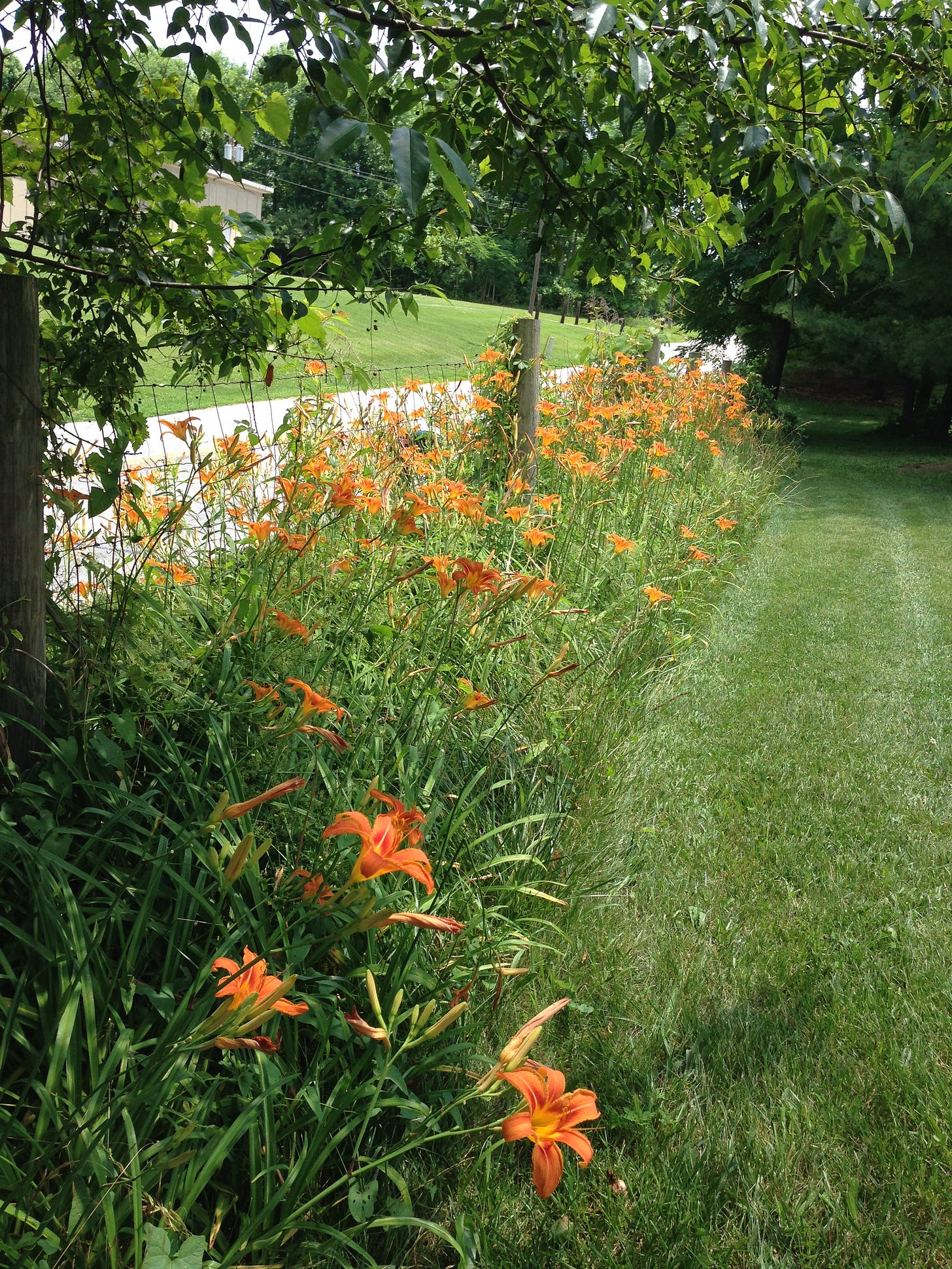
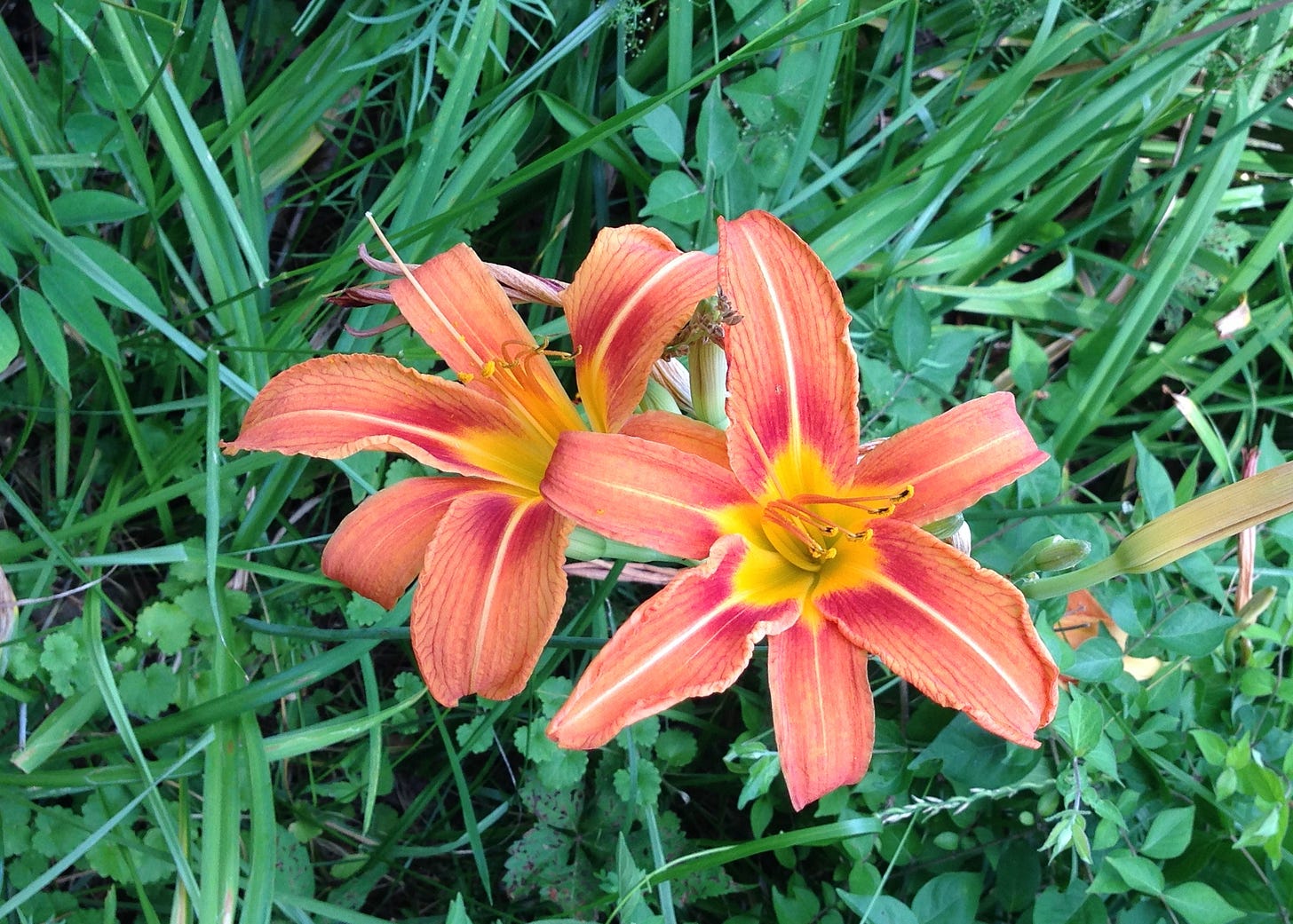

These are some of my favorite summer flowers to enjoy!
From childhood I looked forward to seeing these day lilies every year. Where I grew up, people called them "tiger lilies".
Thanks for reading!! Spread the joy!! :-D